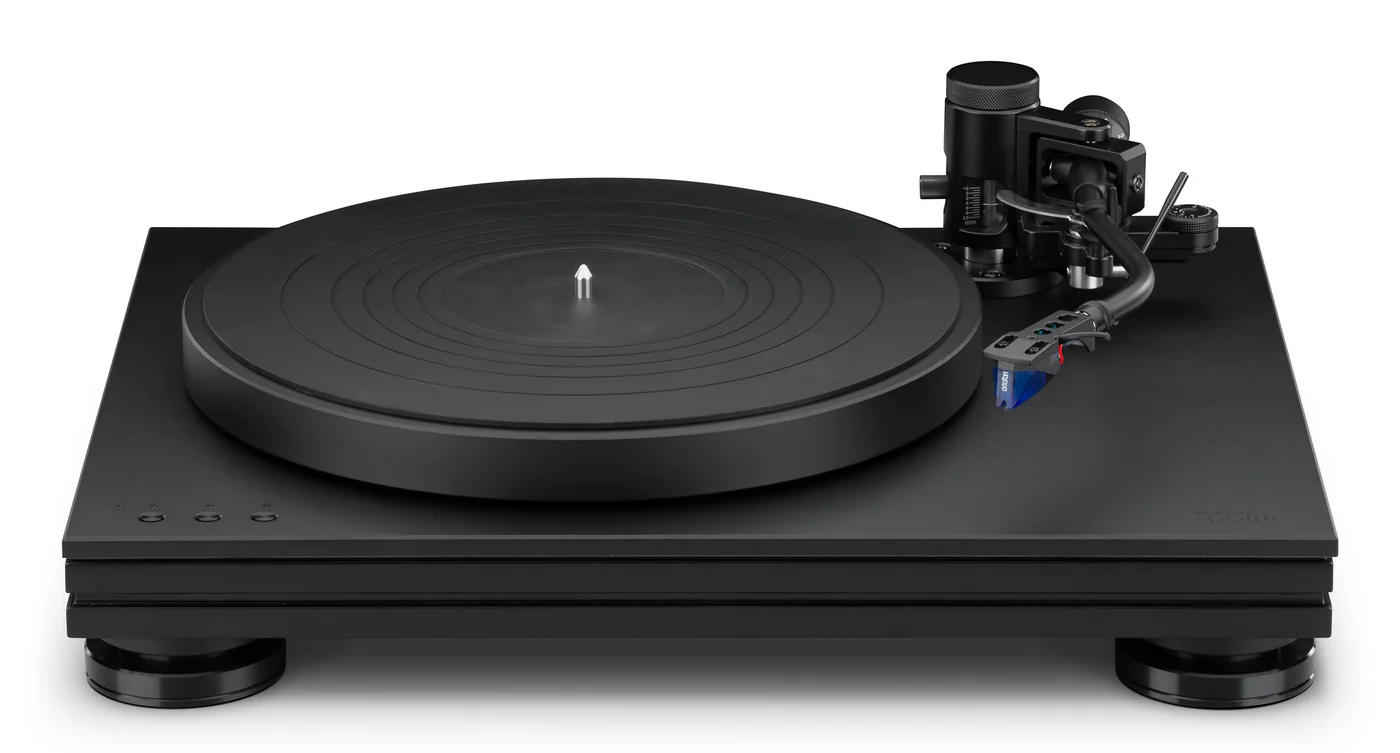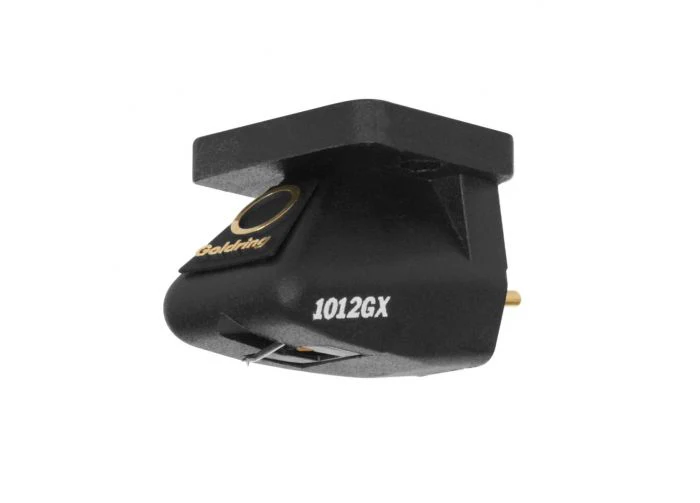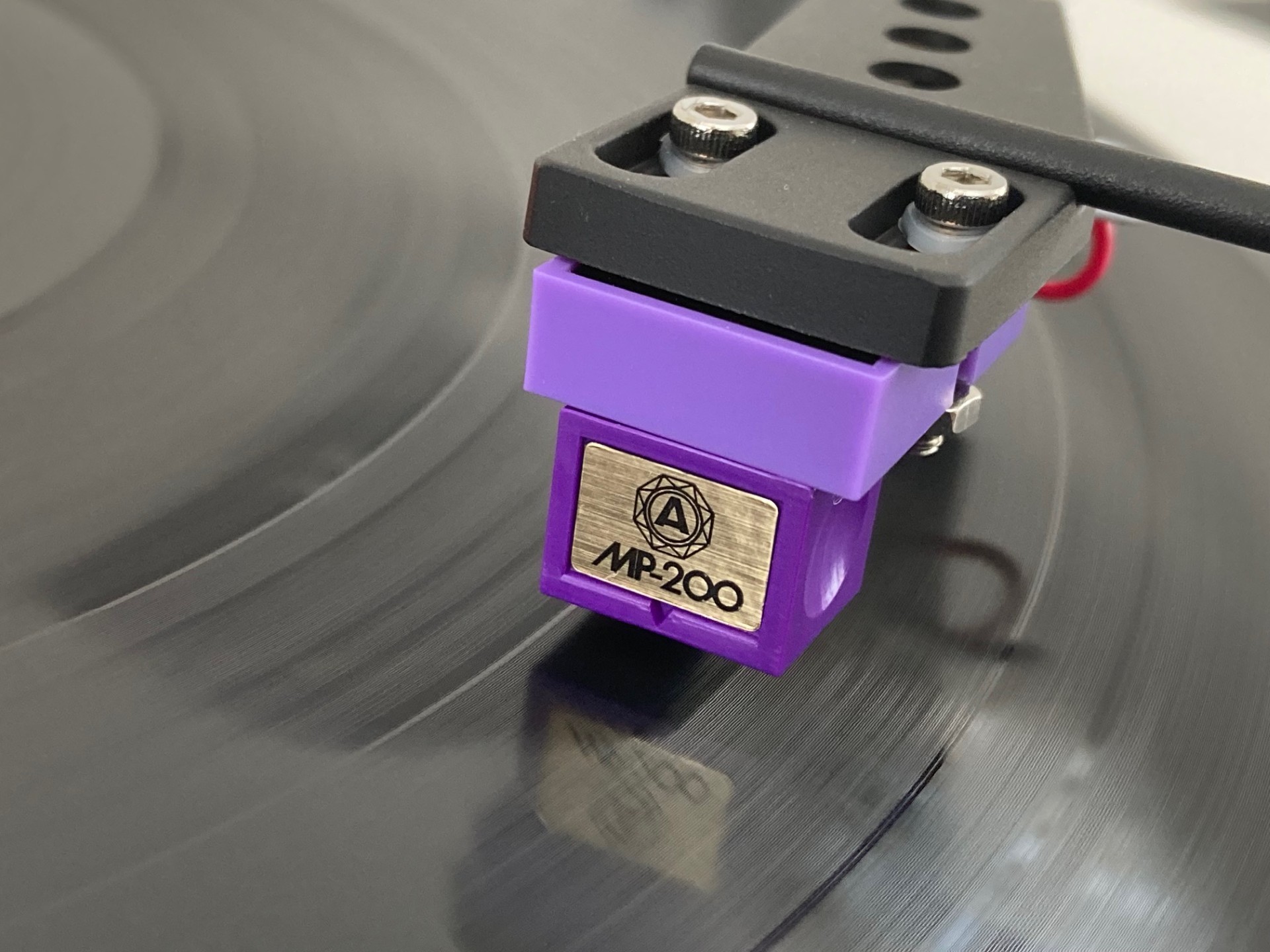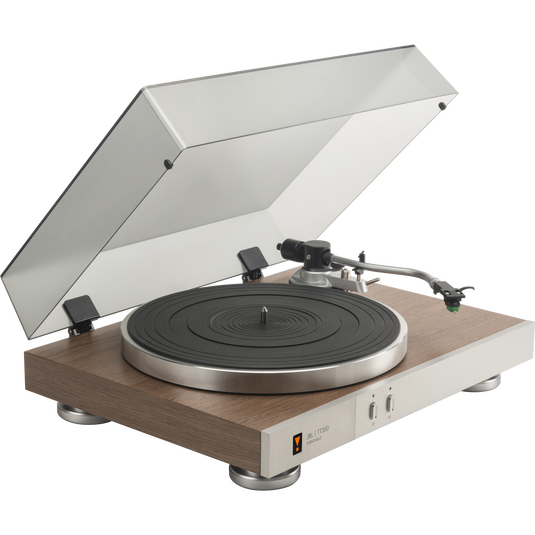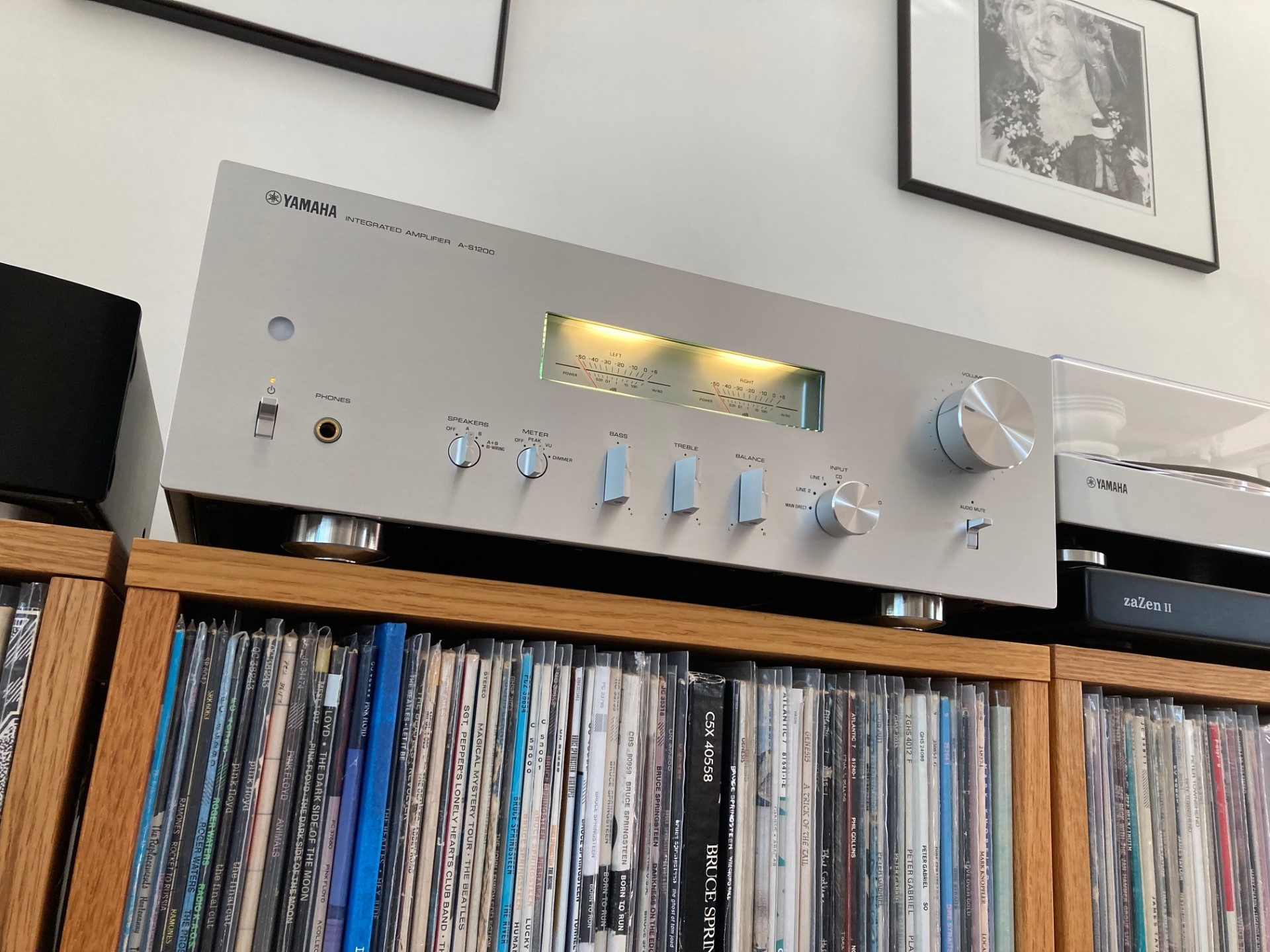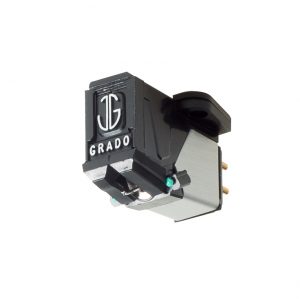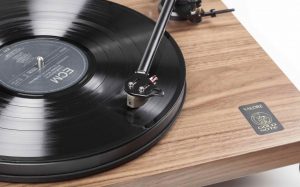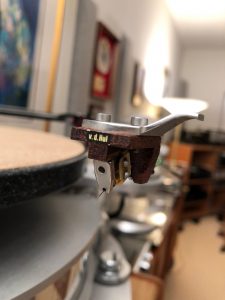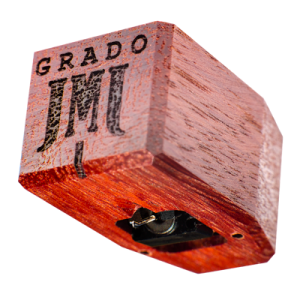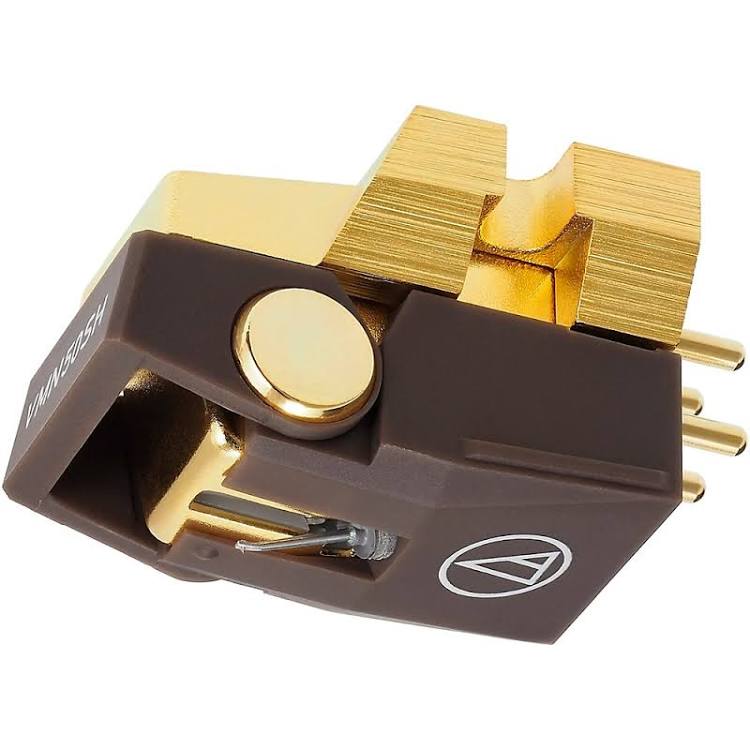
Ten-plus years have passed since I reviewed Audio-Technica's AT150MLx cartridge (HERE), a flagship moving magnet model without the flagship price: just $485 at the time. It featured a gold-plated boron cantilever tipped with a MicroLine stylus, a heavy metal body, MuMetal shielding between the channels and a ceramic mounting base to combat resonance. It was among the very finest of its kind at the time, a true everyman exotic, the likes of which are increasingly rare despite the vinyl resurgence. They're simply too hard, or expensive, to manufacture these days, at least for a tab that enough people are willing to fork over.
The question becomes, can one live without some of those exotic flourishes, and does their absence make a meaningful subtractive difference in the musical experience? Enter the $450 VM750SH, a virtual twin with the same striking (some might say gaudy) gold body and a virtually identical form. What's different? Gone are the boron cantilever, replaced with much less expensive (and easier to produce) aluminum. Also absent is the ceramic mounting plate and possibly the MuMetal shield, replaced by what is now simply described as a "center shield."
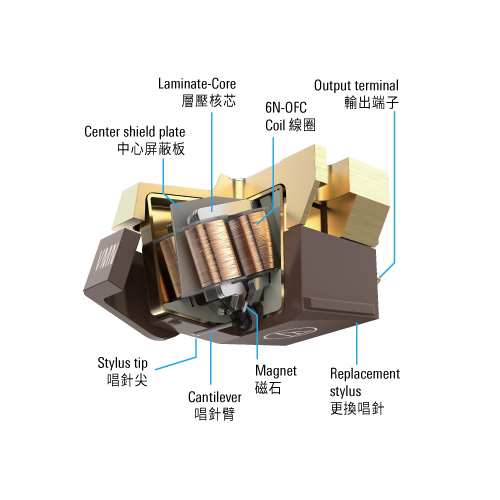
It's not an entirely apples-to-apples comparison here due to the difference in styli, with the VM750SH sporting a Shibata tip versus the old AT150MLX's MicroLine. The actual direct comparison would be to the otherwise identical $350 VM740ML with Microline stylus, but I wanted to match prices more closely. In spirit, however, the $650 VM760SLC is the top of the line, but it uses a special line contact stylus that's a different animal than the MicroLine or Shibata.
Those distinctions are responsible for a stark difference in how the old and new cartridges extract music from the record grooves. While both are decidedly severe profiles, MicroLine styli tend to be brighter with more top-end detail, with detractors noting a tendency toward spotlit high frequencies and perhaps less generous bass. Shibata models, on the other hand, are similarly talented at detail retrieval but more balanced in my experience, though some say they're a little too professorial and businesslike. Some also say the MicroLine profile is technically superior, and with a longer lifespan, despite being less costly to source. Neither rewards ham-fisted or lazy installations, and only perform close to their potential with careful attention to all crucial parameters of cartridge setup.
Audio-Technica is one of the most experienced and longest-running cartridge manufacturers in the world, and I'm an unabashed fan. Most notably, their products have traditionally been excellent values, owing to what I imagine are economies of scale that smaller brands struggle to achieve. Plus, the basic shapes of the VM750SH body and stylus unit, for example, are seemingly unchanged from various iterations that first appeared in the 1980s. They still look contemporary to me, and why change what ain't broken simply for the sake of change? The money AT saves on new styling and tooling helps keep prices down, perhaps.
The only modernization I can see–and it's a useful one–is seemingly lower compliance designed to suit today's heavier and more rigid tonearms. This is evidenced by drastically higher tracking forces, relatively speaking. The AT150MLx tracked at between 0.75 and 1.75 grams, while the VM750SH has a much narrower range of 1.8 to 2.2 grams, with 2 grams as the recommended value. Frequency response is distinctly different between the two: 20-27,000 Hz for the 750 versus 10Hz-23kHz for the 150, with 30dB channel separation @1kHz.
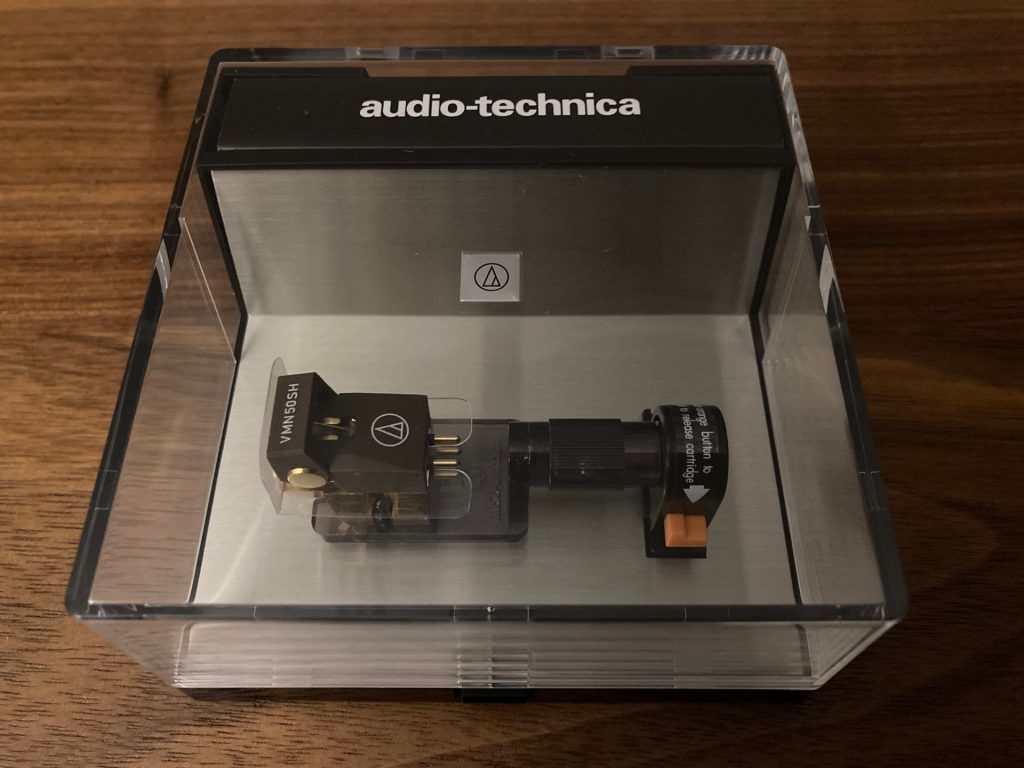
Another thing that hasn't changed much is the packaging. The VM750SH is conveyed in a nice, Plexiglas case with plenty of mounting hardware and a set of high-quality OFC headshell wires, a nice inclusion given the popular resurgence of tonearms with detachable headshells. All in all, it looks virtually identical to the older model, keeps a lot of what made it special like the highly rigid body, and updates its compatibility for the modern era. And the price is about the same, despite ten years of inflation.
This particular Audio-Technica body style has never been the easiest to mount due to the lack of threaded bolt inserts that the company now includes on other cartridges costing as little as $39 (HERE). It's a pain fiddling with screws and nuts and getting them situated inside the open mounting lugs, but that gets back to how much Audio-Technica might need to raise the price of this cartridge if they redesigned the body. I'll gladly tolerate a few minutes of frustration in exchange for saving another $100 or so. The whole shebang is slightly hefty at around 8 grams, but most tonearms and counterweights will abide.
Procedurally, it's best to insert the first screw and nut into the headshell, affix one side of the cartridge, and then install the other screw, which makes the whole operation about 50% easier than trying to do both at once. It takes me two minutes, but after three-plus decades of self-service analog, I can swap cartridges faster than a pit crew at Daytona changes tires. Don't be discouraged if it takes you substantially longer. The good news, then and now, is that the stylus unit slips easily on and off for safety during mounting (and eventual replacement), and the cantilever is clearly visible for alignment purposes.
Running the VM750SH into an Avid Pulsus phono preamp (HERE) should quickly reveal any notable shortcomings, and there simply weren't any. I said then, and will say again, that the AT150MLx's price belied its performance, and many users would never treat it with the respect it deserved to reveal the full extent of its talents. To me, that meant pairing it with a tonearm costing more than the cartridge itself, and a similarly excellent phono preamp like the now-$2250 Avid. Few people did that because moving magnet cartridges aren't even on the radar screens of people who invest that kind of coin. Therefore, I felt a lot less guilty mounting the more prosaic VM750SH on several direct drives under $1000 like the Technics SL-100C, and also the $649 Music Hall Classic, which does not offer any fine tonearm adjustments at all aside from tracking force and anti-skating.
One word sprung to mind once I started listening: resolute. The VM750SH is a serious product, and its central mission seems to be delivering unflinching, but not robotic, extension and detail extraction. But it also bumps along to the beat with crackerjack timing and agility, though probably less so than if it still sported boron for its cantilever. If you derive maximum fun from maximum musical information, then the VM750SH could be for you. Listening to Earl Klugh and Bob James bop through Two of a Kind (Capitol; SMAS-12244), the VM750SH provides toe-tappingly fast results and palpable thump. It's perhaps very slightly spotlit at the high frequencies, lacking the smoothness and integration of the $300 more expensive Hana SH (HERE).
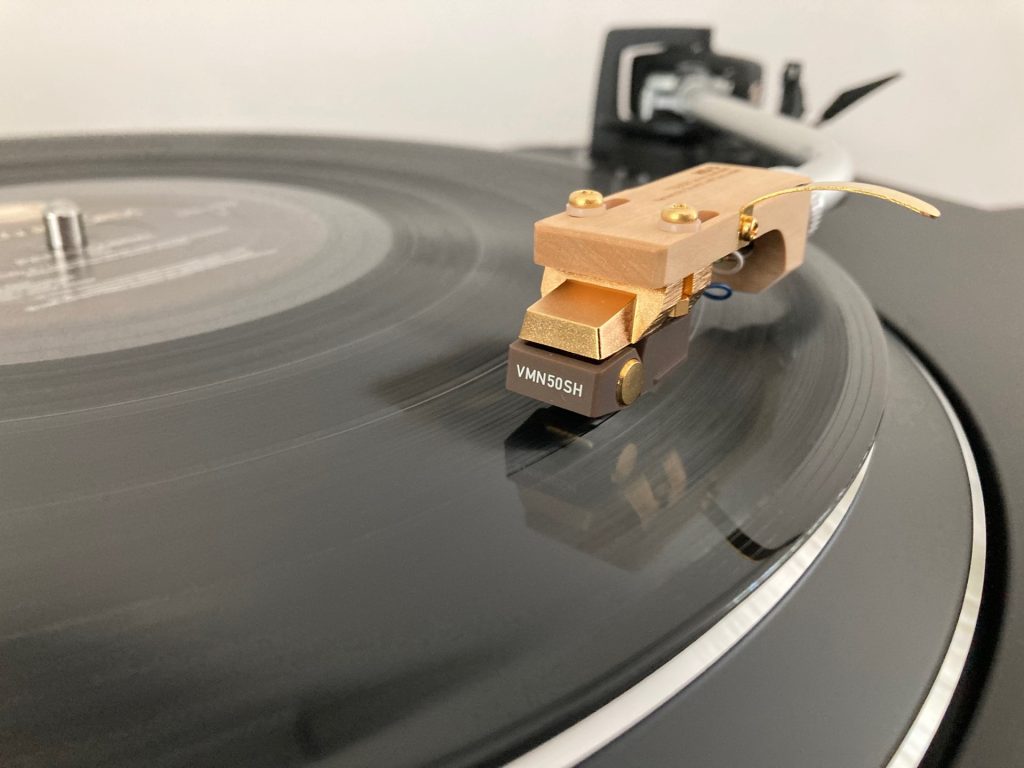
Which brings me back to technical matters for just a second. Audio-Technica suggests capacitive loading between 100-200pf, which is difficult to achieve in most systems. With the Avid Pulsus set at 100pf and a short run of exceptionally low capacitance Blue Jeans Cable, I estimate I'm potentially bumping up against 200pf with tonearm wiring. Many people were probably over 200pf, perhaps substantially so, back when the 440ML and later 150MLx debuted, a time when Audio-Technica's top-tier moving magnets were often criticized for being bright. My guess is that those folks were simply piecing together captive tonearm cables and inbuilt phono preamps ("hey, it says MM phono") with little regard to specs, resulting in cockeyed frequency response due to excessive capacitance. Right now I can say that the 750SH simply sounds unusually resolving and a little airier than usual.
Audio-Technica cartridges with Shibata and MicroLine profiles have always been among the best in their price tiers at reproducing highs and vocals without notable sibilance or etch, and the 750SH is no exception. That alone is, to me, a compelling reason to buy one. There's nothing more distracting than cartridges that audibly fizzle out as they run out of steam higher up, juddering through the grooves while spitting out a tizzy semblance of reality. The 750SH gets it done right, much as the 150MLx did.
An increasing number of cartridges today are marketed as throwbacks to bygone days of "Shures and Stantons" remembered fondly for their "smoothness." (That's actual marketing copy I'm quoting.) For younger listeners, this seems like a way of igniting nostalgia for a time they imagine as idyllic but weren't even alive to experience. They might be better off buying a streaming stereo receiver with tone controls instead. The 750SH isn't for them, pulling information from the grooves with tenacity. As a consequence, it tends to focus the listener on notes more than atmosphere. That said, a closer listen reveals soundstage depth and air fully in line with my expectations for a product that's several big steps up from the entry level. What it does well is split the difference between the richness, ease and big-heartedness of Grado's $300 Opus3 (HERE) and the more forensic-sounding but uniquely entertaining $419 Ortofon 2M Bronze. Serious yes, but not at all businesslike and lacking fun.
I've reviewed my share of Audio-Technica cartridges over the years, perhaps because there are so many to choose from, perhaps because the company continually rolls out new models, but more likely because they're always worthwhile musically and solid monetarily. The VM750SH may not be a stone-cold bargain like the 150MLx was, but darn if it isn't close in ways that matter most. It's another exceptional cartridge in a long line of them. That's never been more important than now, when high-res streaming is as close as your cell phone. The VM750SH delivers analog with digital-like precision, without sacrificing too much of the liquidity and mental ease of record reproduction. Highly recommended–just watch that darn capacitance.
Specifications
- Frequency Response: 20 Hz to 27 kHz
- Channel Separation: 30 dB (1 kHz)
- Tracking Force: 1.8 to 2.2 g (2.0 g standard)
- Recommended Load Impedance: 47 kOhms
- Output: 4.0 mV (at 1 kHz, 5 cm/sec)
- Channel Balance: 1.0 dB (1 kHz)
- Stylus Type: 2.7 x 0.26 mil Shibata
- Cantilever: Aluminum tapered pipe
- Impedance Coil: 2.7 kOhms (1 kHz)
- DC Resistance: 800 Ohms
- Load Capacitance: 100 to 200 pF
- Coil Inductance (Le): 460 mH (1 kHz)
- Static Compliance: 40 x 10-6 cm/dyne
- Dynamic Compliance: 10 x 10-6 cm/dyne (100 Hz)
- Vertical Tracking Angle: 23°
- Dimensions: 0.7 x 0.7 x 1.1" (17.3 x 17.0 x 28.2 mm)
- Weight: 8.0 g
AT-VM750SH Phono Cartridge
Retail: $449
Audio-Technica U.S., Inc.
1221 Commerce Drive
Stow, Ohio 44224
330.686.2600




